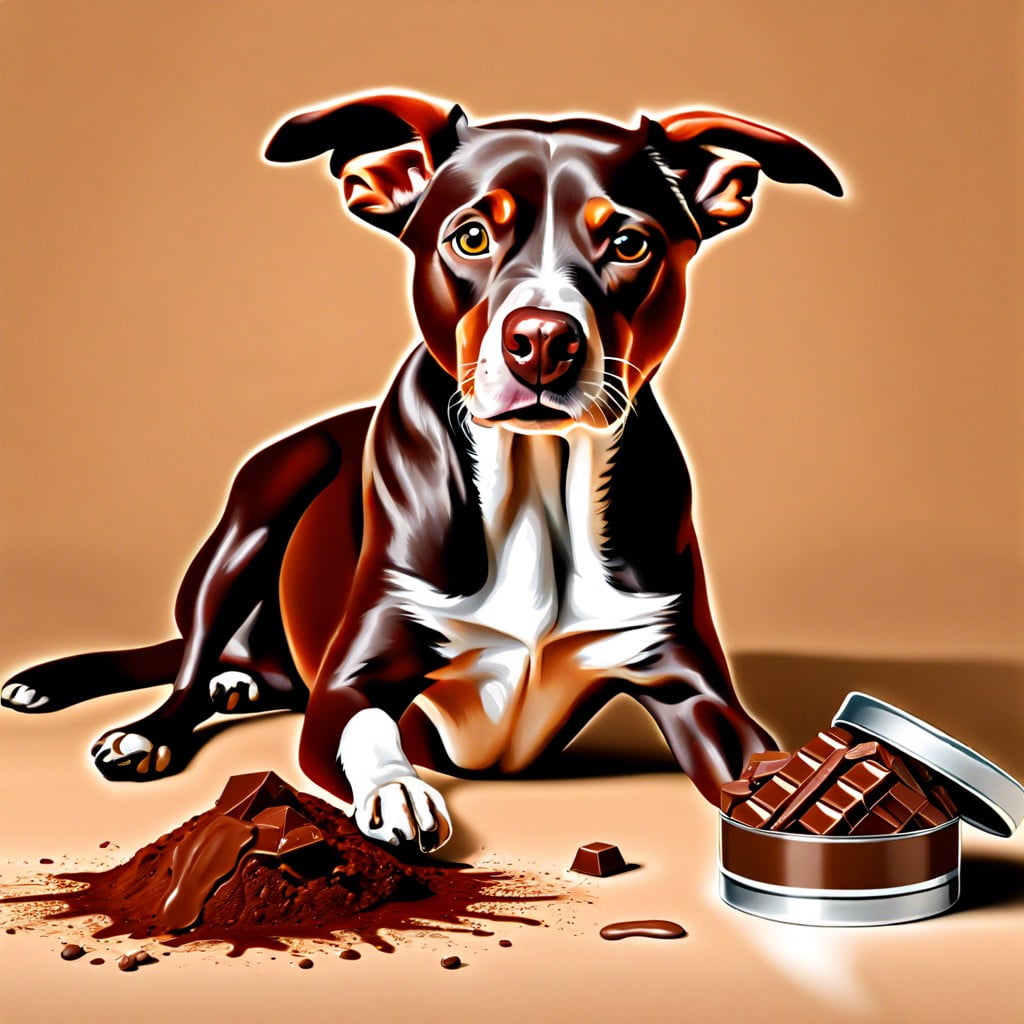This article will provide easy steps to follow when your dog unintentionally consumes chocolate, outlining home remedies to help mitigate potential hazards.
Key takeaways:
- Assess the Type and Amount of Chocolate Ingested
- Contact a Veterinarian Immediately
- Recognize Symptoms of Chocolate Poisoning
- Understanding Chocolate Toxicity Levels in Different Dog Sizes and Breeds
- Monitor Your Dog Closely for Any Changes
Inside
Assess the Type and Amount of Chocolate Ingested

Identifying the specifics of chocolate consumption is crucial for your dog’s health. Dark, milk, and white chocolate contain varying levels of theobromine and caffeine, the compounds toxic to dogs. The darker and more bitter the chocolate, the greater the risk. For instance, baker’s chocolate and high-cocoa content chocolates pose more danger than milk chocolate.
Determine the amount of chocolate your dog has eaten relative to their body weight. A large breed may tolerate a small piece of milk chocolate, while a small breed may not. Take into account any wrappers or packaging that might complicate your dog’s digestion.
If possible, make a note of the chocolate type and estimate the quantity ingested. This information is vital for the vet to evaluate the severity of the situation and decide on the appropriate actions to ensure your dog’s safety.
Contact a Veterinarian Immediately
Upon realizing your dog has consumed chocolate, it is crucial to seek professional guidance without delay. A veterinarian will offer specific advice based on the dog’s size, the type of chocolate ingested, and the amount consumed.
They may instruct you on how to induce vomiting or administer activated charcoal, which can prevent the absorption of toxins. In some cases, they might recommend an immediate visit to the clinic for treatment.
Providing accurate details to the vet, including the timing and any symptoms observed, can be instrumental in protecting your dog’s health. Remember, home remedies should never replace expert veterinary care when dealing with potential chocolate poisoning.
Recognize Symptoms of Chocolate Poisoning
Prompt intervention can be crucial following chocolate ingestion by dogs, so being able to swiftly identify signs of chocolate poisoning is vital. Symptoms can appear within six to twelve hours and may include:
- Vomiting and diarrhea, which may sometimes contain blood
- Restlessness and hyperactivity
- Rapid breathing or panting
- Increased heart rate
- Muscle tremors or seizures
- Weakness or collapse
In severe cases, chocolate toxicity can lead to cardiac failure, coma, or even death. Each dog may exhibit different symptoms, and the severity largely depends on the amount and type of chocolate consumed. If any of these signs are observed, seek veterinary assistance immediately as these are indicators of a serious condition needing prompt medical attention.
Understanding Chocolate Toxicity Levels in Different Dog Sizes and Breeds
Chocolate contains theobromine and caffeine, two stimulants that dogs cannot metabolize effectively. Toxicity levels vary based on the dog’s size, breed, and the type of chocolate:
1. Size Factor: Generally, smaller dogs face a greater risk of chocolate poisoning because it takes a smaller amount of chocolate to affect their body weight. Therefore, what might be a harmless piece for a Great Dane could be dangerous for a Chihuahua.
2. Breed Sensitivity: Some dog breeds may have a higher sensitivity to theobromine. For example, herding breeds like Border Collies or Australian Shepherds may react more severely to smaller quantities due to their genetic makeup and metabolism.
3. Chocolate Type: The darker and more concentrated the chocolate, the higher the risk. For instance, baker’s chocolate and dark chocolate contain more theobromine and caffeine than milk chocolate, making them more toxic.
4. The Math: To gauge the risk level, consider the type of chocolate and the weight of your dog. Approximately one ounce of milk chocolate per pound of body weight is a potential lethal dose. For dark chocolate, as little as one ounce for every three pounds can be dangerous.
5. Individual Health: Pre-existing health conditions can exacerbate the effects of theobromine. Dogs with heart conditions, for example, might be more at risk from even small amounts of chocolate.
Understanding these factors allows you to better estimate the potential danger if your dog consumes chocolate and to provide more accurate information to a veterinarian.
Monitor Your Dog Closely for Any Changes
After ensuring your dog hasn’t consumed a dangerous amount of chocolate and contacting your vet, vigilance is key.
Keep an eye on your pet for the next 24 hours, as symptoms can take time to appear. Look for signs of restlessness, excessive thirst, a rapid heartbeat, vomiting, or diarrhea. These may signal the onset of theobromine poisoning.
Note any unusual behavior, such as muscle tremors or seizures, and report them to your vet immediately. Ensure your dog has access to fresh water, as hydration can help with mild cases of chocolate ingestion. Remember, even if your dog appears fine initially, symptoms can develop later, so continuous monitoring is crucial for their safety.




